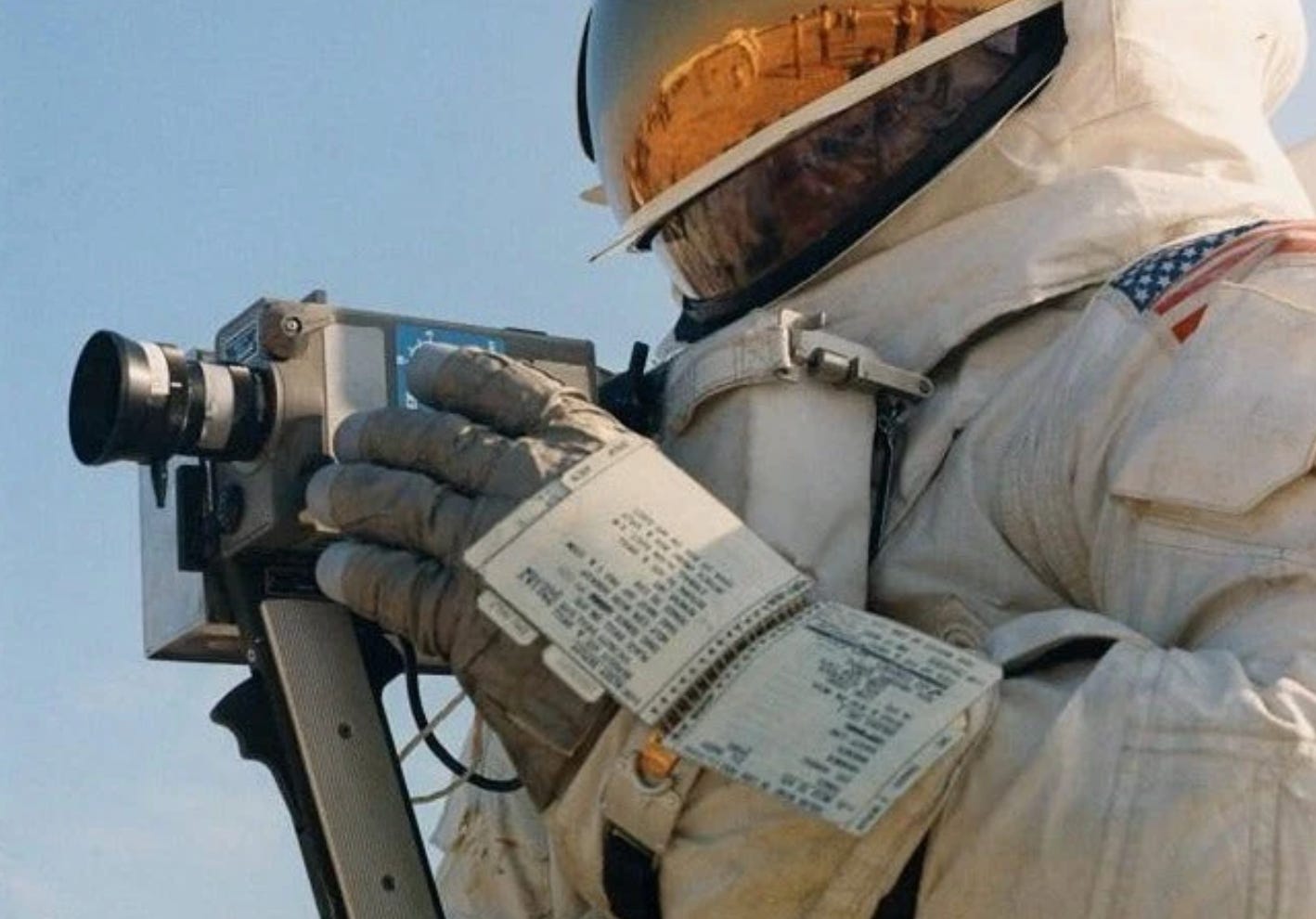Only a few books have been to the moon. They look like shrunken reference binders: square, tabbed, utilitarian, spiral bound. About three inches tall, the spine of a moon book sprouts from a velcro bracelet, which wraps the left cuff of a spacesuit.1 Inside the moon books are spacewalk instructions: mini manuals for how to walk on the lunar surface. (NASA needs an editor to help it write better titles: it calls spacewalks “EVAs” and moon books “cuff checklists.”) We have sent men to walk on the moon, and books for them to read while they walk. What we have not sent to the moon is literature.2 What books should be read on the moon? What titles belong in a lunar library?
If the idea of sending a library into space seems absurd, keep in mind that the moon already has a museum. According to its website, The Museum of Contemporary Art on the Moon, or MOCAM, “is the first museum in space.” Hours and directions? It is “located just South of craters Helicon and Leverrier.” MOCAM’s website does not mention parking. Welcome, earthling, to the museum.
MOCAM’s mission is to introduce lunar audiences to art from Earth. The museum’s collecting parameters commemorate the first moon walk: all MOCAM’s art was made after the year 1969. If it sounds like this museum may not be real—well, it is and it isn’t. MOCAM has a striking building, designed by Mexican architect Mauricio Mastropiero. So what if the building hasn’t been built? It’s only a matter of time. The deed to twenty acres of moon land—just south of craters Helicon and Leverrier—is in the name of the Museum. Meanwhile, exhibitions “are currently presented on the museum’s website,” with the caveat that “all MOCAM artists are asked to sign a document” confirming they will lend their work to the moon when the museum officially opens. Based on the digital exhibits, the real opening is bound to be … stellar.
Even if there is no library on the moon, there is a library in orbit. The International Space Station is home to about 100 books (such as Mars Is No Place for Children); its library even has a small children’s section. A few titles are worth consideration, but some may not merit reading even on Earth, unless you love John Grisham and Dan Brown. There are endless worlds to discover in outer space, which has yet to discover the world of independent literary publishing.
In contrast to the predictable literature at the International Space Station, moon books surprise you sometimes. Some even feature nudes. The books from Apollo 12 include Angela Dorian (Miss September 1967), Reagan Wilson (Miss October 1967), Cynthia Myers (Miss December 1968), and Leslie Bianchini (Miss January 1969). Perhaps women have been to the moon after all. According to the astronaut Dave Scott, the prank was difficult to pull because it involved printing Playboy centerfolds on “fire-proof plastic-coated paper.” This means that moon books do not burn. If we send the first literature to the moon, it will be safer there than on Earth.
non-exhaustive selection of GALACTIC LINKS
The Habitat - The true story of six volunteers picked to live on a fake planet.
Live in Peace or Leave the Galaxy by Birchwood Palace Industries
UFO-related projects by olivier
Astronaut's Sewn-in-Space Star Shines at Quilt Festival
Starglass - Access to the world's largest historical images of stars, galaxies, and Space. StarGlass allows you to search the Harvard Plate Stacks collection for glass plate negatives by the date they were made, the astronomical objects they captured, the historic Women Astronomical Computers that used them, and much more.
NASA Glenn Interns Take Space Washing Machine Designs for a Spin
I have the same wool slippers astronauts wear in space!!!! (and I love them)
Solar system quilt, made in Iowa in 1876
The computer that navigated Apollo 11 to the moon was handwoven
Sewing spacesuits audio documentary
Interview with an astronaut who’s into sewing
International Library Telescope Program
As exciting as I find the idea of moon books, cuff checklists seem ordinary and unexciting as books. While there are many ways to define and problematize the category of “book”; the cuff checklists check the boxes of even the most conventional conceptions. They are bound along one edge, have pages that turn, and can be read. The cuff checklists even qualify, officially, as miniature books, which must be 3.5 inches tall or less. When we ask the question, “what is a book?” moon books are not an interesting case study.
This seems like such a missed opportunity, until you remember that we’ve never bothered to send women, cis or trans, to the moon; no nonbinary feet have blessed the lunar surface.




